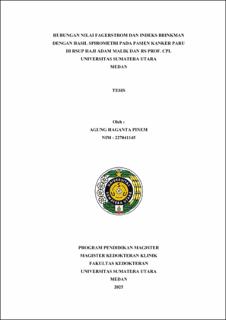Hubungan Nilai Fagerstrom Dan Indeks Brinkman Dengan Hasil Spirometri Pada Pasien Kanker Paru Di Rsup Haji Adam Malik Dan Rs Prof. Cpl Universitas Sumatera Utara Medan
Correlation Between Fagerstrom Score And Brinkman Index With Spirometry Results In Lung Cancer Patients At Haji Adam Malik General Hospital And Prof. Dr Chairuddin P. Lubis Universitas Sumatera Hospital Medan

Date
2025Author
Pinem, Agung Haganta
Advisor(s)
Tarigan, Setia Putra
Tarigan, Amira Permatasari
Metadata
Show full item recordAbstract
Background: Lung cancer is the leading cause of cancer-related deaths worldwide, with
smoking being the main risk factor. Nicotine dependence can be assessed using the
Fagerstrom Test for Nicotine Dependence (FTND), and smoking intensity can be
evaluated through the Brinkman Index. Both parameters may affect lung function
measured by spirometry.
Objective: To investigate the relationship between Fagerstrom score and Brinkman Index
with spirometry results in lung cancer patients at RSUP Haji Adam Malik and RS Prof.
CPL Universitas Sumatera Utara.
Methods: This is a quantitative observational study with a cross-sectional design. A total
of 68 lung cancer patients with a history of smoking were enrolled. Data were collected
using Fagerstrom and Brinkman Index questionnaires and spirometry tests. Statistical
analysis was conducted using the Kruskal-Wallis test with a significance level of p<0.05.
Results: The majority of patients had a moderate Fagerstrom score (44.1%) and a
moderate Brinkman Index (52.9%). Spirometry results revealed a high prevalence of
obstructive and restrictive lung disorders. There was a significant correlation between
Fagerstrom score and Brinkman Index with spirometry outcomes (p<0.001).
Conclusion: There is a significant relationship between Fagerstrom score and Brinkman
Index with impaired lung function in lung cancer patients.
